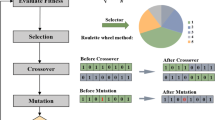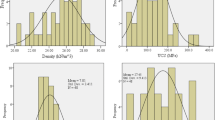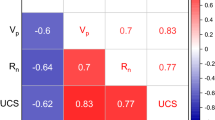Abstract
The Brazilian tensile strength (BTS) test is the most common method to evaluate the tensile strength in mining and civil engineering projects. This paper aims to employ the genetic algorithm (GA) and particle swarm optimization (PSO) for predicting the BTS. For this work, linear and power equations were considered and their weights were optimized By GA and PSO. To achieve the objective of this research, a database including 80 sets of data were prepared so that dry density (DD), Schmidt hammer (Rn), and point load (IS50) parameters were used as the independent parameters. After modeling, the accuracy of PSO linear, PSO power, GA linear and GA power models were assessed using coefficient correlation (R2) and root mean square error (RMSE). According to the obtained results, it was found that both GA and PSO optimization algorithms proposed in this research predicted the BTS values satisfactorily; however, PSO power model with the R2 of 0.963 demonstrated a better generalization capability and it can be used for similar problems in the future. Also, the values of R2 for the PSO linear, GA Linear and GA power models were 0.958, 0.948 and 0.962, respectively.







Similar content being viewed by others
References
Baykasoğlu A, Güllü H, Çanakçı H, Özbakır L (2008) Prediction of compressive and tensile strength of limestone via genetic programming. Expert Syst Appl 35:111–123
Heidari M, Khanlari GR, Kaveh MT, Kargarian S (2012) Predicting the uniaxial compressive and tensile strengths of gypsum rock by point load testing. Rock Mech Rock Eng 45(2):265–273
Khandelwal M, Armaghani DJ (2016) Prediction of drillability of rocks with strength properties using a hybrid GA-ANN technique. Geotech Geol Eng 34:605–620. https://doi.org/10.1007/s10706-015-9970-9
Mechanics IS for R (2007) The complete ISRM suggested methods for rock characterization, testing and monitoring: 1974–2006
Singh VK, Singh D, Singh TN (2001) Prediction of strength properties of some schistose rocks from petrographic properties using artificial neural networks. Int J Rock Mech Min Sci 38:269–284
Nazir R, Momeni E, Armaghani DJ, Amin MFM (2013) Correlation between unconfined compressive strength and indirect tensile strength of limestone rock samples. Electron J Geotech Eng 18 I:1737–1746
Sheorey PR (1997) Empirical rock failure criteria. A.A. Balkema, Rotterdam
Mishra DA, Basu A (2012) Use of the block punch test to predict the compressive and tensile strengths of rocks. Int J Rock Mech Min Sci 51:119–127. https://doi.org/10.1016/j.ijrmms.2012.01.016
Perras MA, Diederichs MS (2014) A review of the tensile strength of rock: concepts and testing. Geotech Geol Eng 32:525–546. https://doi.org/10.1007/s10706-014-9732-0
Monjezi M, Hasanipanah M, Khandelwal M (2013) Evaluation and prediction of blast-induced ground vibration at Shur River Dam, Iran, by artificial neural network. Neural Comput Appl 22(7–8):1637–1643
Toghroli A, Mohammadhassani M, Suhatril M et al (2014) Prediction of shear capacity of channel shear connectors using the ANFIS model. Steel Compos Struct 17:623–639
Mohammadhassani M, Saleh A, Suhatril M, Safa M (2015) Fuzzy modelling approach for shear strength prediction of RC deep beams. Smart Struct Syst 16(3):497–519
Safa M, Shariati M, Ibrahim Z et al (2016) Potential of adaptive neuro fuzzy inference system for evaluating the factors affecting steel-concrete composite beam’s shear strength. Steel Compos Struct 21:679–688
Amiri M, Bakhshandeh Amnieh H, Hasanipanah M, Mohammad Khanli L (2016) A new combination of artificial neural network and K-nearest neighbors models to predict blast-induced ground vibration and air-overpressure. Eng Comput 32:631–644
Toghroli A et al (2016) Potential of soft computing approach for evaluating the factors affecting the capacity of steel–concrete composite beam. J Intell Manuf. https://doi.org/10.1007/s10845-016-1217-y
Taheri K, Hasanipanah M, Bagheri Golzar S, Abd Majid MZ (2016) A hybrid artificial bee colony algorithm-artificial neural network for forecasting the blast-produced ground vibration. Eng Comput 33(3):689–700
Mansouri I et al (2016) Strength prediction of rotary brace damper using MLR and MARS. Struct Eng Mech 60(3):471–488
Hasanipanah M et al (2016) Prediction of an environmental issue of mine blasting: an imperialistic competitive algorithm-based fuzzy system. Int J Environ Sci Technol. https://doi.org/10.1007/s13762-017-1395-y
Mansouri I, Shariati M, Safa M et al (2017) Analysis of influential factors for predicting the shear strength of a V-shaped angle shear connector in composite beams using an adaptive neuro-fuzzy technique. J Intell Manuf. https://doi.org/10.1007/s10845-017-1306-6
Hasanipanah M, Jahed Armaghani D, Khamesi H, Bakhshandeh Amnieh H, Ghoraba S (2016) Several non-linear models in estimating air-overpressure resulting from mine blasting. Eng Comput 32(3):441–455
Toghroli A et al (2018) Evaluation of the parameters affecting the Schmidt rebound hammer reading using ANFIS method. Comput Concr 21(5):525–530
Rezaei M (2018) Forecasting the stress concentration coefficient around the mined panel using soft computing methodology. Eng Comput. https://doi.org/10.1007/s00366-018-0608-4
Rezaei M (2018) Feasibility of novel techniques to predict the elastic modulus of rocks based on the laboratory data. Int J Geotech Eng. https://doi.org/10.1080/19386362.2017.1397873
Parsaei MR, Mollashahi H, Darvishan A, Mir M, Simoes R (2018) A new prediction model of solar radiation based on the neuro-fuzzy model. Int J Ambient Energy. https://doi.org/10.1080/01430750.2018.1456964
Duan M, Darvishan A, Mohammaditab R, Wakil K, Abedinia O (2018) A novel hybrid prediction model for aggregated loads of buildings by considering the electric vehicles. Sustain Cities Soc 41:205–219
Yilmaz I (2009) A case study from Koyulhisar (Sivas-Turkey) for landslide susceptibility mapping by artificial neural networks. Bull Eng Geol Environ 68:297–306
Singh M, Singh B (2012) Modified Mohr–Coulomb criterion for non-linear triaxial and polyaxial strength of jointed rocks. Int J Rock Mech Min 51:43–52
Tonnizam Mohamad E, Hajihassani M, Jahed Armaghani D, Marto A (2012) Simulation of blasting-induced air overpressure by means of artificial neural networks. Int Rev Modell Simulat 5(6):2501
Najafzadeh M, Barani G-A, Azamathulla HM (2013) GMDH to predict scour depth around a pier in cohesive soils. Appl Ocean Res 40:35–41
Armaghani DJ, Faradonbeh RS, Rezaei H et al (2016) Settlement prediction of the rock-socketed piles through a new technique based on gene expression programming. Neural Comput Appl. https://doi.org/10.1007/s00521-016-2618-8
Bejarbaneh BY, Bejarbaneh EY, Amin MFM et al (2016) Intelligent modelling of sandstone deformation behaviour using fuzzy logic and neural network systems. Bull Eng Geol Environ. https://doi.org/10.1007/s10064-016-0983-2
Gordan B, Armaghani DJ, Adnan AB, Rashid ASA (2016) A new model for determining slope stability based on seismic motion performance. Soil Mech Found Eng 53:344–351. https://doi.org/10.1007/s11204-016-9409-1
Hasanipanah M, Jahed Armaghani D, Bakhshandeh Amnieh H et al (2016) Application of PSO to develop a powerful equation for prediction of flyrock due to blasting. Neural Comput Appl. https://doi.org/10.1007/s00521-016-2434-1
Armaghani DJ, Hasanipanah M, Amnieh HB, Mohamad ET (2018) Feasibility of ICA in approximating ground vibration resulting from mine blasting. Neural Comput Appl 29:457–465
Kennedy J, Eberhart RC (1995) A discrete binary version of the particle swarm algorithm. In: Systems, man, and cybernetics, computational cybernetics and simulation, 1997 IEEE international conference on IEEE, pp 4104–4108
Mohamad ET, Armaghani DJ, Momeni E et al (2016) Rock strength estimation: a PSO-based BP approach. Neural Comput Appl. https://doi.org/10.1007/s00521-016-2728-3
Poli R, Kennedy J, Blackwell T (2007) Particle swarm optimization. Swarm Intell 1:33–57
Hasanipanah M, Shahnazar A, Amnieh HB, Armaghani DJ (2017) Prediction of air-overpressure caused by mine blasting using a new hybrid PSO–SVR model. Eng Comput 33(1):23–31
Shahnazar A, Nikafshan Rad H, Hasanipanah M, Tahir MM, Jahed Armaghani D, Ghoroqi M (2017) A new developed approach for the prediction of ground vibration using a hybrid PSO-optimized ANFIS-based model. Environ Earth Sci 76(15):527
Hasanipanah M, Shahnazar A, Arab H, Bagheri Golzar S, Amiri M (2017) Developing a new hybrid-AI model to predict blast-induced backbreak. Eng Comput 33(3):349–359
Darvishan A, Mollashahi H, Ghaffari V, Janghorban Lariche M (2018) Unit commitment-based load uncertainties based on improved particle swarm optimization. Int J Ambient Energy. https://doi.org/10.1080/01430750.2017.1423384
Eskandar H, Heydari E, Hasanipanah M, Jalil Masir M, Mahmodi Derakhsh A (2018) Feasibility of particle swarm optimization and multiple regression for the prediction of an environmental issue of mine blasting. Eng Comput 35(1):363–376
Hassan R, Cohanim B, De Weck O, Venter G (2005) A comparison of particle swarm optimization and the genetic algorithm. In: 46th AIAA/ASME/ASCE/AHS/ASC structures, structural dynamics and materials conference, pp 1897
Holland JH (1975) Adaptation in natural and artificial systems: an introductory analysis with applications to biology, control, and artificial intelligence. MIT Press, Cambridge
Lima CAS Jr, Lapa CMF, do Pereira NA CM, et al (2011) Comparison of computational performance of GA and PSO optimization techniques when designing similar systems–typical PWR core case. Ann Nucl Energy 38:1339–1346
Chambers LD (1998) Practical handbook of genetic algorithms: complex coding systems. CRC Press, Boca Raton
Behzadafshar K, Esfandi Sarafraz M, Hasanipanah M, Farid S, Tahir FM MM (2017) Proposing a new model to approximate the elasticity modulus of granite rock samples based on laboratory tests results. Bull Eng Geol Environ. https://doi.org/10.1007/s10064-017-1210-5
Hasanipanah M, Golzar SB, Larki IA, Maryaki MY, Ghahremanians T (2017) Estimation of blast-induced ground vibration through a soft computing framework. Eng Comput 33(4):951–959
Mohamad ET, Faradonbeh RS, Armaghani DJ et al (2016) An optimized ANN model based on genetic algorithm for predicting ripping production. Neural Comput Appl. https://doi.org/10.1007/s00521-016-2359-8
Ulusay R, Hudson JAISRM (2007) The complete ISRM suggested methods for rock characterization, testing and monitoring: 1974–2006
Hasanipanah M, Bakhshandeh Amnieh H, Arab H, Zamzam MS (2016) Feasibility of PSO–ANFIS model to estimate rock fragmentation produced by mine blasting. Neural Comput Appl. https://doi.org/10.1007/s00521-016-2746-1
Hasanipanah M, Noorian-Bidgoli M, Jahed Armaghani D, Khamesi H (2016) Feasibility of PSO-ANN model for predicting surface settlement caused by tunneling. Eng Comput 32(4):705–715
Hasanipanah M, Naderi R, Kashir J, Noorani SA, Zeynali Aaq Qaleh A (2017) Prediction of blast produced ground vibration using particle swarm optimization. Eng Comput 33(2):173–179
Hasanipanah M, Shahnazar A, Bakhshandeh Amnieh H, Jahed Armaghani D (2017) Prediction of air-overpressure caused by mine blasting using a new hybrid PSO–SVR model. Eng Comput 33(1):23–31
Nikafshan Rad H, Hasanipanah M, Rezaei M, Eghlim AL (2017) Developing a least squares support vector machine for estimating the blast-induced flyrock. Eng Comput. https://doi.org/10.1007/s00366-017-0568-0
Keshtegar B, Kisi O (2017) M5 model tree and Monte Carlo simulation for efficient structural reliability analysis. Appl Math Model 48:899–910
Keshtegar B, Heddam S (2017) Modeling daily dissolved oxygen concentration using modified response surface method and artificial neural network: a comparative study. Neural Comput Appl. https://doi.org/10.1007/s00521-017-2917-8
Keshtegar B, Mert C, Kisi O (2018) Comparison of four heuristic regression techniques in solar radiation modeling: Kriging method vs RSM, MARS and M5 model tree. Renew Sustain Energy Rev 81:330–341
Hasanipanah M, Jahed Armaghani D, Bakhshandeh Amnieh H, Koopialipoor M, Arab H (2018) A risk-based technique to analyze flyrock results through rock engineering system. Geotech Eng G. https://doi.org/10.1007/s10706-018-0459-1
Keshtegar B, Kisi O (2018) RM5Tree: Radial basis M5 model tree for accurate structural reliability analysis. Reliab Eng Syst Safe 180:49–61
Acknowledgements
The work is executed with the support of the Grant of Ministry of education of Russia no. 5.3606.2017/PCH. Also, the authors would like to express their sincere appreciation to Dr. Hasanipanah for his cooperation in developing the idea of this research.
Author information
Authors and Affiliations
Corresponding author
Additional information
Publisher’s Note
Springer Nature remains neutral with regard to jurisdictional claims in published maps and institutional affiliations.
Rights and permissions
About this article
Cite this article
Surendar, A., Kuzichkin, O.R., Kanagarajan, S. et al. Applying two optimization techniques in evaluating tensile strength of granitic samples. Engineering with Computers 35, 985–992 (2019). https://doi.org/10.1007/s00366-018-0645-z
Received:
Accepted:
Published:
Issue Date:
DOI: https://doi.org/10.1007/s00366-018-0645-z




